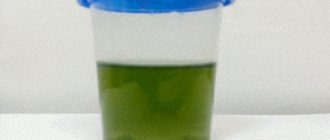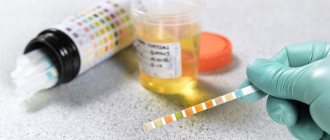A change in the color of biological fluid will definitely alarm every person. If he notices that he has orange urine when he defecates, it is recommended that he go to a urologist for an appointment, who will schedule tests. Only an experienced doctor, after conducting a thorough diagnosis, will be able to determine the true cause of the change in urine color.
There are many provoking factors that cause orange urine in women, men and children. They may indicate the progression of various pathological processes in the body, or they may not pose any danger. In the latter case, the biological fluid will have this shade for a short period of time.
Physiological reasons
Morning urine is more saturated in color due to an increase in antidiuretic hormone. This substance is produced during sleep and delays urine production. That's why people usually don't get up to go to the toilet at night.
Under the influence of the hormone, the concentration of urobilinogen in the urine increases, which gives it a characteristic shade.
The baby's urine may be orange for 5-6 days after birth. This is due to the fact that uric acid and urate crystals are released in the urine of a newborn. If the baby is fed with mother's milk or a selected formula, then the urine gradually acquires a straw color.
Causes
Every disease is provoked by something, pushes the process of its development. Treatment of symptoms is known to be ineffective. It is important to identify what caused it and eliminate it. The appearance of orange urine cannot be without reason.
In both men and women, the change in the color of urine is due to the content of urochrome, urobilinogen and other elements in it. They are coloring substances and accumulate in the body mainly at night, so morning urine has a more intense color. The orange tint of waste products itself is not a pathology, but may indicate certain disorders.
Among women
Urinary problems are very common in women. The length of the urethra is much shorter when compared with men, so pathogenic microflora easily penetrates through it into other parts, including the bladder and kidneys.
If you notice a darkening of the color of your urine, but do not experience any discomfort, remember what you have eaten recently. The appearance of orange urine in women is common and appears spontaneously.
If you change your diet, start drinking more fluids, and eliminate the use of “coloring” medications, but this change persists for several days in a row, then you should go to the clinic and get tested.
During pregnancy
Urinary problems are very common during pregnancy. Many women who undergo tests while expecting a child are diagnosed with the presence of inflammatory diseases (urethritis, cystitis, etc.) But the urine is also assessed externally, and not only with the help of laboratory tests, to identify the presence of leukocytes (or red blood cells, which should not be there) in it. .
A common cause of orange urine in pregnant women is insufficient fluid intake. You should drink at least a liter of water a day. The expectant mother often dramatically changes her diet and begins to consume many new food additives. Thus, the color of the urine may change, and this frightens the woman.
In the last months of pregnancy, pregnant women experience gestosis. This is a condition accompanied by increased blood pressure, the appearance of protein in the urine (as a result, it may acquire a reddish tint) and severe swelling.
In children
A mother who has a newborn baby is very worried about the appearance of pink or orange spots on the diapers. In the first days of life, the discharge of a little boy or girl is orange in color, because they receive a little milk, and the urine is concentrated and bright.
Uric acid crystals can be seen on the baby's light-colored clothing. This is a normal phenomenon that goes away after a few days - when the woman begins to produce milk. The baby's urine turns yellow and there is practically no smell.
Even a slight change in the diet leads to the appearance of an unusual shade of the baby's discharge. Often mothers, fearing hypovitaminosis in their child, give him too much carrot and pumpkin juice. In addition to the vegetables listed, some fruits also add “brightness” to children’s secretions. But this is an adequate reaction of a healthy body.
Sometimes the orange color of urine is evidence of increased excretion of urate in the urine in newborns with uric acid infarction (not considered a pathological condition), or taking rifampicin (a drug for the treatment of tuberculosis).
In men
In men, as in women, the color of urine changes depending on the foods consumed, medications and illnesses. Darkening of urine, its orange tint may indicate problems in the liver (the likelihood of disease in this organ increases if a person notices that, in parallel with the appearance of brightly colored urine, his stool has become lighter, and the whites of the eyes have acquired a yellowish tint) or pancreas (pancreatitis) .
The appearance of amber-yellow and orange-colored urine in men most often indicates dehydration, diseases of the liver and bile ducts. Medicines such as Rifampin, Azulfidine and Pyridium can give urine an unusual color.
Coloring foods and drinks
Orange color of urine may appear due to the consumption of large quantities of certain foods:
- carrot;
- pumpkin;
- persimmon;
- asparagus;
- tomatoes;
- citrus;
- raspberries;
- sea buckthorn;
- spinach.
Dark orange urine appears after drinking red or yellow carbonated drinks, chips, crackers and other snacks. This change occurs due to the removal of artificial dyes from the body.
Some preservatives and flavor enhancers added to prepared foods can color urine.
Children at 2-3 years old are given carrot or pumpkin juice to provide the child’s body with vitamins. Orange urine is a natural result of such supplements.
This is not dangerous to health, but you should still slightly reduce the amount of food. The bright orange hue of the fruit indicates its ability to cause allergies.
Normal Causes of Discolored Urine
Before upsetting and frightening readers, let's consider reasons that do not conceal danger. For example, the physiological process mentioned in the title of the article is influenced by:
- medications;
- food products;
- insufficient amount of fluid during the day.
Let's look at each of them in more detail.
Medicines
First of all, the following can cause the appearance of orange urine:
- Rifampin is an antibiotic used to treat tuberculosis.
- Pyridium is an analgesic and antispasmodic medicine used for diseases of the urinary tract and bladder.
- Multivitamins. B vitamins have a particularly strong effect on the color changes in discharge. If you take them in tablet or injection forms, then a change in the shade of the liquid indicates their complete absorption by the body. Riboflavin (B2) is always present in multivitamins in fairly high doses. It is water-soluble and its excess is excreted by the kidneys.
- Azulfidine (sulfasalazine). It is used in the treatment of disorders of the lower digestive system: diarrhea, abdominal pain, colitis and other inflammatory bowel diseases.
Menu
Products with a high content of coloring pigment also affect the color of the discharge.
Carrots, pumpkin, orange, beets, persimmons - these fruits and vegetables can color your urine, giving it a red and orange tint. If you ate any of the above this day or last evening, then do not be surprised by such changes.
The easiest way to find out that everything is in order is to stop eating the listed foods and monitor: if everything returns to normal, then the phenomenon was caused precisely by dietary habits.
Dehydration
The most common reason. A person should drink at least 1.5 liters of clean water per day. This volume does not include carbonated drinks, tea, coffee, juices and liquid first courses.
It is advisable to place a container of water in a visible place in the kitchen, the contents of which must be consumed within a day. Very often, people do not drink even a liter of liquid, while abusing coffee (and this drink only worsens dehydration).
Poisoning and vomiting lead to dehydration.
Bright orange urine due to dehydration
The loss of large amounts of fluid can be caused by:
- intense sports activities;
- lack of drink in the heat.
A person loses moisture through the skin, which means the volume of urine produced decreases. At the same time, the amount of residual metabolic products and salts remains unchanged. A decrease in the volume of fluid excreted by the kidneys leads to an increase in the concentration of particles excreted from the body in the urine.
Dehydration is a dangerous condition. If you do not replenish lost moisture, this will lead to metabolic disorders and kidney problems.
How to restore urine color yourself
If a healthy woman experiences a change in the color of her urine, the main thing is not to panic, but to try to make the following adjustments yourself.
- It is worth paying attention to your diet and reducing your salt intake.
- It is necessary to completely give up smoking and alcohol. These bad habits may well provoke a change in the color of urine.
- Every day you need to drink water and various liquids in a volume of two or more liters. This helps the body function properly.
- We need to play sports, be outdoors more often.
- It is recommended to visit a gynecologist and follow all instructions.
If a change in the color of urine is observed for two days, then there is nothing dangerous about it. If this condition lasts several days, then you need to consult a doctor.
Having certain information about changes in the color of urine, every woman will take care of her health in a timely manner.
Diseases of the genitourinary system
An unusual orange color may indicate diseases of the urogenital tract:
- Urolithiasis disease. Uric acid, which causes sand and kidney stones to form, gives biological fluid an orange tint.
- Pyelonephritis. Inflammation in the kidney is caused by bacterial microflora. Pathogenic microorganisms provoke color changes.
- Cystitis. Inflammation in the bladder, in addition to changes in the color indicator, is accompanied by pain when urinating and frequent urge to go to the toilet. The color turns orange due to small amounts of blood.
- Tumors. Malignant and benign neoplasms change the color of urine.
- Injuries. Bruises of the lower back or abdomen can cause rupture of small blood vessels. The orange color appears due to blood impurities.
- Urinary disorders. Stagnation of urine leads to the fact that a large amount of metabolic products is concentrated in the liquid.
- Prostate diseases. With adenoma or inflammation, the prostate gland compresses the urethra and makes urination difficult. This is accompanied by an increase in the concentration of metabolic products.
With genitourinary diseases, additional symptoms do not always immediately develop. Sometimes the first sign of a pathological process is only orange urine. If the long-term discoloration is not related to the use of medications or products, you should visit a doctor.
What to do if your urine turns orange
If symptoms indicating kidney and urinary tract diseases appear, you should consult a doctor. He will order all the necessary studies. An important diagnostic measure is to examine freshly collected urine for the presence of bacteria. This is important if the patient's urine is bright orange and pink. Bacterial culture, culture on a nutrient medium - studies that help determine the presence of the causative agent of an infectious disease, its type and prescribe an effective antibacterial agent.
General and biochemical blood tests make it possible to determine kidney diseases, which cause bright orange urine. For such tests to be effective, you must adhere to the recommendations: donate blood on an empty stomach, and the day before, avoid drinking alcohol, fatty foods, and other hard-to-digest foods.
If symptoms indicating kidney and urinary tract diseases appear, you should consult a doctor.
If the orange color appears due to dietary habits, then you should not be upset. Pigments that enter the body are eliminated some time after a person stops consuming brightly colored foods. The same applies to dehydration.
Restoring the usual water regime will help normalize the color, and the yellow-orange urine will become lighter.
Diseases of other organs
A change in color indicator is not always associated with problems of the urinary organs. Orange coloration of the fluid secreted by the kidneys occurs in other pathological conditions:
- poisoning;
- cholecystitis;
- liver inflammation;
- heart disease;
- intestinal infections.
Orange urine in men and especially women occurs due to sexually transmitted diseases. In women - due to a shorter and wider urethra, where germs from the vulva and vagina easily penetrate.
Treatment
The appearance of orange urine should be a reason to consult a doctor. Based on studies of the biochemical composition of blood and urine and other diagnostics, appropriate treatment will be prescribed.
Pregnant women should undergo regular examination by a gynecologist.
To get a complete picture of the disease, the doctor will send you for an ultrasound of the bladder, kidneys, and liver examination. If a disease related to the genitourinary system is detected, treatment will be carried out by a urologist.
For effective treatment, it is necessary to identify the root causes of the disease that led to deviations from the norm. It is possible that poor nutrition has caused disturbances in the body. In this case, treatment is prescribed and the diet is changed. Health directly depends on the patient’s lifestyle.
Why is urine orange during pregnancy?
Normally, a pregnant woman's urine is light yellow or straw-colored. If orange urine appears in women during pregnancy, this is a possible consequence of the following phenomena:
- Toxicosis. Vomiting and indigestion lead to fluid loss, and the urine changes color. The resulting condition is dangerous for the woman and the fetus.
- Preeclampsia. It occurs in late pregnancy and is accompanied by disruption of the functioning of internal organs. Without treatment it leads to the death of the pregnant woman.
If a pregnant woman does not feel unwell, but the urine has acquired an orange tint, then the cause may be the intake of vitamin complexes, as well as fruit juices.
Changes in the color of urine in women
The regularly excreted urine of a healthy person is distinguished by shades of yellow. Depending on the changes occurring in the body, urine changes color and turns orange. This may be due to factors such as:
- increased concentration of urochrome pigment,
- taking certain medications
- eating foods containing dyes
- urinary tract disorder
- lack of fluids during intestinal infections,
- lack of physical activity,
- the presence of gestosis in pregnant women.
For women, a change in urine color from yellow to orange is the first sign of a urinary tract disorder. In this case, you need to pay attention to the unpleasant odor and turbidity of the urine. If they are present and emptying is painful, then the woman needs qualified help from a specialist. In such situations, you should not self-medicate or postpone a visit to the doctor.
Sometimes doctors associate changes in the color of urine in women with heart disease, kidney disease, injury, or a fever. This should raise concerns, so you need to go to a doctor who will conduct an examination, identify the exact cause and give his recommendations.
If the color of the urine turns orange, this condition is accompanied by high body temperature, as well as frequent vomiting, sharp pain in the abdomen and back, then this is an alarming signal that requires an immediate visit to the doctor.
What other symptoms should you pay attention to?
If the urine is orange, then other characteristics of the material should be assessed:
- Transparency. Cloudiness occurs when there is excess mucus.
- Presence of sediment. You need to let the urine “settle” for a while, and then carry out an assessment. In a healthy person, no precipitate forms.
- Smell. An unpleasant smell of urine occurs with inflammation of the urinary tract or with sexually transmitted diseases.
Changes in the characteristics of the fluid and signs such as lower back pain, swelling, itching are reasons to take a test for laboratory testing.
Orange urine should not be ignored if the color changes persist for a long time and are not associated with medications or coloring products. Some diseases can be asymptomatic for a long time, and the only sign will be a change in the color indicator.
Diagnostics
To identify pathological processes that provoke the appearance of orange urine, laboratory diagnostic methods are used.
These include:
- General urine analysis - a comprehensive laboratory test that reveals the physical and chemical characteristics of urine. Biological material taken for further study is assessed according to several indicators, namely: color, transparency, specific gravity and acidity. The analysis also determines the presence of specific substances: glucose, leukocytes, ketone bodies, bile pigments. For the analysis, morning urine is used, which is studied using microscopic examination. The average cost is 200 rubles.
- A urine sample according to Nicheporenko is a study that evaluates the quantitative content of red blood cells, leukocytes and casts contained in 1 ml of urine. Often, this study is used to clarify or confirm the diagnosis indicated by the results of a general urine test. For the sample, an average portion of urine is taken, collected in the morning immediately after waking up. To do this, the first 15-20 ml of urine is poured into the toilet, the next portion (about 30 ml) is collected in a special container, and the rest of the urine is poured into the toilet again. Analysis results can be obtained one day after the biological material is submitted. Cost – about 400 rubles.
- Bacteriological urine analysis is a study used to identify a pathogen in the body that has provoked the development of an inflammatory process in the organs of the urinary system. The diagnostic method is used when a general urine test indicates bacteriuria. The seeding tank gives a detailed picture of the composition of the pathogenic flora and indicates the specific name of bacteria and fungi. To carry out the study, the biomaterial is Gram stained, which makes it possible to recognize the pathogen under a microscope with an immersion lens. Next, the urine being tested is placed on special nutrient media that are favorable for the development of pathogenic bacteria and examined under a microscope. The cost of analysis is from 1000 rubles.
To identify the inflammatory process, laboratory blood tests are also used:
- A general blood test is a comprehensive clinical study that evaluates the qualitative and quantitative composition of the blood. The analysis allows you to determine the volume of leukocytes, erythrocytes and platelets. For diagnosis, venous or capillary blood collected in the morning is used. Biological material is examined under a microscope. The cost of the analysis is about 200 rubles.
- A biochemical blood test is a complex laboratory test consisting of a number of tests, the composition of which varies depending on the disease being diagnosed. Venous blood is used as a biomaterial for analysis. The results of the study are prepared within 1 day. Cost – from 400 rubles.
Instrumental diagnostics are used to examine the kidneys and urinary system in case of urolithiasis or suspected pyelonephritis.
Instrumental methods include:
- Kidney ultrasound or bladder allows you to assess the functioning of organs and identify, if any, stones of any type and location are present, as well as track structural changes in the renal tissue during pyelonephritis. Cost – from 1000 rubles.
- X-ray diagnostics is represented by survey urography , which visualizes the general structure and location of the organs of the urinary system. The method allows you to detect the presence of radiological stones in the bladder, kidneys or ureter. Cost – from 1800 rub.
- Computed tomography is a method used to diagnose urolithiasis. Instrumental research allows you to determine the exact location, size and density of stones. Cost – from 5000 rub.
Pay attention to the smell
Not only the color of urine, but also the smell can indicate the development of the inflammatory process. If your urine becomes cloudy or has a strong, unpleasant odor, you most likely have to deal with a bacterial infection. It is necessary to urgently consult a doctor if, against the background of this symptom, swelling appears and the number of urinations has significantly decreased without changing the volume of fluid consumed. The described signs may indicate cardiovascular pathology.
Any change in the body’s usual state requires a thorough examination. Even such a harmless symptom as a change in urine color often indicates the development of the disease. People who monitor their health, pay attention to all manifestations of the body, are much less susceptible to serious illnesses.
Exclusively female reasons
Red-orange urine may indicate the development of cystitis. Women most often experience the disease. This is due to the special structure of the urethra. Any hypothermia can cause inflammation of the bladder. Reddish color of urine is an alarming symptom. It is possible that there is blood in the urine. Treatment of the disease should be under the supervision of a doctor. Most often, therapy is carried out in a hospital setting.
Changes in the color of urine during pregnancy are also considered dangerous. Preeclampsia in the last stages can lead to serious dehydration of the body. This cannot but harm the baby who is developing in the womb. If swelling appears that does not go away for a long time, a woman should definitely make an appointment with a doctor.











